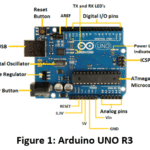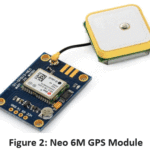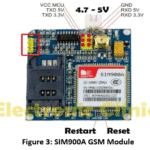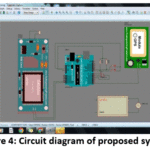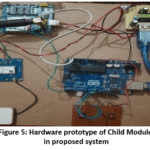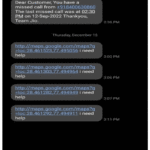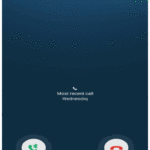Gopal Bhardwaj* , Monika Dixit
, Monika Dixit , Ginni Kumari
, Ginni Kumari , Khushi Kumari
, Khushi Kumari and Shreya Srivastava
and Shreya Srivastava
Electronics and Communication Engineering Department, Greater Noida Institute of Technology, Greater Noida, Uttar Pradesh, India.
Corresponding Author E-mail: gopalbhardwaj2001@gmail.com
DOI : http://dx.doi.org/10.13005/ojcst16.01.04
Article Publishing History
Article Received on : 20 Apr 2023
Article Accepted on : 25 May 2023
Article Published : 05 Jun 2023
Plagiarism Check: Yes
Reviewed by: Dr. K. Vengatesan Second Review by: Dr. Navin Kumar
Second Review by: Dr. Navin Kumar Final Approval by: Dr. Piyush N. Patel
Final Approval by: Dr. Piyush N. Patel
Article Metrics
ABSTRACT:
Wearable tracking gadget that school-age children can wear is the topic of this paper. It doesn't need any pricy technology to operate.. This technology is usable by persons of all educational levels. It has got two buttons one is alert button and another is panic button The major objective of this gadget is to ensure that the youngster may contact their parents in an emergency. The alert button allows the child to notify their parents of an emergency and provide their current location. For communication, the current technology includes Bluetooth, WI-FI, and RFID. It is hard to communicate across a great distance with these technologies because they only have a narrow range of coverage. Also they are not that accurate. This device solves the issue by utilizing GSM technology. Parents do not need to submit any special code to the device to determine the child's location's latitude and longitude. If a child is in any emergency situation and wants his/her parents to know their current exact location. If a child feels uneasy, there are two methods to let the parents know. The cell phone of the parents or guardian receives the alarm message via SMS by pressing alert button and if the child wants to communicate to parents immediately, a call can also be made via this device using the panic button and the child can talk to the parent in real time.
KEYWORDS:
Child safety; Calling feature; Embedded system; GPS; GSM; Microcontroller; School going children
Copy the following to cite this article:
Bhardwaj G, Dixit M, Kumari G, Kumari K, Srivastava S. Arduino Uno Based Child Tracking System Using GPS and GSM. Orient.J. Comp. Sci. and Technol; 16(1).
|
Copy the following to cite this URL:
Bhardwaj G, Dixit M, Kumari G, Kumari K, Srivastava S. Arduino Uno Based Child Tracking System Using GPS and GSM. Orient.J. Comp. Sci. and Technol; 16(1). Available from: https://bit.ly/3C8HgqG
|
Introduction
This device is basically an
embedded system prototype of the wearable device we plan to introduce. A device
or system that has distinct functionalities integrated into it and real-time
computation is called an embedded system. It consists of both hardware and
software. Embedded systems are crucial for the development of new technologies. Many industries, including the
defense industry, the automotive industry, the medical equipment industry, and
other commercial applications, particularly in automation, can employ the
combination of hardware and software. The fact that kids are more vulnerable
and kidnapping and missing children are a common occurrence is one of the
motivations for this wearable device. These incidents increase when we talk
about school going children. As a result, the child can also send a message to
their parents if they are missed in a crowd or lose their way home. Two
different push buttons are used for sending SMS and CALL at the parent’s mobile
phone.
The system’s device is small and
compact, which is another improvement. This gadget can be created in a wearable
form, such as a bracelet or watch, so that kids can use it effectively.
There are two modules in this
system. The initial one involves the parents. It is basically a mobile phone
for receiving calls and messages. The rest of the device is contained in the
second module, which is the kid module. It includes a microcontroller, emergency
keys, GPS, GSM, and a power source. Consequently, the primary goal of this
paper is to assist parents in finding or rescuing their children when they are
in trouble.
Literature review
To track and find children, numerous systems have been suggested.
Certain systems require child to carry a mobile phone.[2]
Some of them require designing of two different hardware modules.[3]
Some use Bluetooth technology for communication.[1]
Some use RFID to locate the child.[4]
Most of the proposed child modules are larger in size and have numerous modules.[4]
Smart Watches with internet connectivity or photo gallery facility in it are prohibited in classes and exam hall that’s why our system will not require internet connectivity and does not have camera attached, to avoid this situation.
As mentioned in above point we found some
promising techniques for tracking child’s location but there were some issues
in these systems .In a research paper published in 2018,the author mentioned a
system where they designed two different hardware modules one for the child and
other for parent. Also in a research paper published in 2013 it is required for
child to carry a smart phone for tracking location ,a school going child can
surely not carry ta smart phone with them. These are some issues we intend to
resolve in this paper.
Material
and methods
Proposed system can be largely classified into
three subsystems. The first one is the Arduino UNO R3 microcontroller system.
It is the central unit of our device.
To
construct the suggested system, this Arduino Uno is interfaced with the GPS and
GSM modules.
Components
Arduino UNO
Essentially a circuit board, Arduino uno is
used to create electronics projects involving some coding.
The microcontroller based on the
ATmega328P, Arduino UNO contains 16 mhz ceramic resonator, six analogue inputs
, a USB port, an icsp header, a reset button , and a power jack. Additionally,
it also contains 14 digital input and output pins, of which six are output pins
for PWM. Everything required to support the microcontroller is included. To begin, all we need to do
is utilise a USB cable to link it to a computer, and Use a battery or an
AC-to-DC adaptor to power it.
Neo 6M GPS module
The usage of the Global Positioning
System is the most accurate and fastest method of determining your location.
A built-in
EEPROM and an antenna are included in the Neo 6M GPS module.
Interface:
TTL RS232
3V-5V Power
Supply
Standard
baudrate is 9600 bps.
Use
standard NMEA sentences.
SIM900A GSM Module
The module
offers GPRS/GSM technology for use in mobile sim-based communication. Mobile
telephony and SMS transmission and reception employ the 900 MHz and 1800 MHz
frequency bands, respectively.
Methodology
Here, we are developing a tool that can be worn as a wearable to track a student’s position in real time. Also it should allow children to make contact with their parents in a situation of need. Therefore to achieve both these operations we are going to follow these few steps :
Interface Neo 6m Module with Arduino UNO.
Interface Gsm SIM900A module with Arduino UNO.
Once both these components are interfaced successfully with our microcontroller unit we can now programme our arduino uno for doing the task it is to perform.
Once the code is compiled successfully on Arduino IDE we upload it on our arduino.
We have also provided a microphone which is interfaced to SIM900A GSM module for transmission of voice of child during the call.
The device
is to be provided with two push buttons ,one for sending sms to the registered
mobile no.(parents number) other one is for calling parent in case the child
wants to talk to their parents.
Using the
Neo 6M Gps module, our primary objective is to continuously obtain the device’s
location (latitude and longitude) and send it to Arduino whenever it requests
it.
Whenever
the push button for sms in toggled the latitude and longitude are fed to the
arduino .The arduino converts them into a google map’s link and transmits a
message to the registered no. saying “I NEED HELP” with this google link
containing the location of the device.
GSM SIM900A
module is used to transmit this message from the device to the parent’s mobile
as well as to make calls from the child’s device.
A LED is also
interfaced with arduino as indicator to identify whether it is call which is
being made or is it sms.When a call is made it turns red and when an SMS is
sent it turns green.
Improvisations
Existing commercial systems use technologies such as bluetooth and wifi for communication ,these technologies have limited range of communication.therefore we used GSM technology for communication.
Existinting systems have child module bigger in size and required to be carried by the child therefore ,we proposed wearable device which is small in size.
No existing system have real time calling facility,but this system provides calling facility on one mobile no. (parent’s mobile no.)
Proposed system does not require any internet connectivity and also does not have any camera attached so as to make sure that the child is allowed to carry the device (e.g in form of wrist band) in class as well as in exam hall.
Circuit diagram
Working model
Results and Discussion
The
proposed model has two responses :
Case 1: When the button for sending SMS is
triggered ,A SMS is sent to the pre registered mobile no. in the device i.e
parents mobile number. This SMS contains a google map’s link for the location
of the device with a message “I need Help”.
Case 2 : When the button for making a call
is triggered a call is sent to the pre registered mobile no. in the device i.e
the parent’s mobile number. The parent can receive the call and hear what the
child has to say. The microphone interfaced to the GSM module facilitates the
transmission of voice of the child.
Applications
Whenever the child misses his/her bus back from school and is getting late .Then they can inform their parents by calling them.
When the child is in any situation when he/she does not feel safe they can send the text as well as call their parents to let them know their location.
If any mishappening takes place with the child like kidnapping the child can send his her location to their parents and also can call parents to let them know about the situation.
These are a few of many possible applications this device can serve for a child.
Future scope
This research is about a Smart IoT
device for children safety and tracking helping the parents to locate their
children when they are in danger. The future scope of the project is to
implement the IoT device which ensures the complete solution for child safety
problems .To convert it into a wearable watch or wristband etc.
Conclusion
We have reviewed all the existing technologies for child tracking systems and come up with this system with following improvements:
It has a vast range of communication due to SMS and calling using GSM technology.
It is compact in size and so as to make it easily portable.
It has a calling facility which is not provided in any child tracking device.
Using a microphone the child can talk
to their parents whenever they are in a situation where they want to contact
their parents.
Acknowledgement
For all the assistance they
gave me to finish this research, I’d want to express my gratitude to my
college’s GNIOT and ECE department. For this research, the electronics lab has
been quite helpful. Therefore, I want to thank everyone.
Conflict
of Interest
The authors declare that there is no conflict of interests
regarding publication of this article.
Funding Source
The authors
declare that the funding is done by authors only.
References
- Children tracking and security system using Bluetooth system and security system( 2019 9th IEEE international conference on control system, computer and engineering(ICCSCE)29 NOV-1DEC 2019,Penang,Malaysia)
- GPS and GSM based child tracking system using smartphone A. Al-Mazloum, E omer, M.F.A Abdullah World Academy of Science ,Engineering and Technology International Journal of Electronics and Communication Engineering,VOL: 7,No: 2,2013
- Child Tracking System ,International Journal of Engineering Research and Technology(IJERT) ISSN:2278-0181 published by www.ijert.org RTICCT 2018 conference proceedings
- Shruti Anant Tiwarkar, Shaila Suresh Bhumannavar,Gaurav Kishor Kshirsagar,Aishwarya Dinkar Ghare International Journal of Innovative Science and Research Technology ISSN No. -2456-2165
- Child safety wearable device by Akash Moodbidri, Hamid Shahnasser(IEEE 2017)
- End to end safety solution for children enabled by a wearable sensor vest (Journal of Uniquitous Systems and Pervasive Networks 2015, Mirjami Jutilla,Pekka Karhulab)
- B. Dorsemaine, 1. P. Gaulier, 1. P. Wary, N. Kheir and P. Urien, “Internet of Things: A Definition and Taxonomy,” Next Generation Mobile Applications, Services and Technologies, 2015 9th International Conference on, Cambridge, 2015, pp. 7277.
- K. Braam, Tsung-Ching Huang, Chin-Hui Chen, E. Montgomery, S. Vo and R. Beausoleil, “Wristband Vital: A wearable multisensor microsystem for real-time assistance via low-power Bluetooth link,” Internet of Things (WF-IoT), 2015 IEEE 2nd World Forwn on, Milan 2015, pp. 87-9l. doi: 10.l109/WFIoT.2015.7389032
- “Digital parenting: The best wearables and new smart baby monitors. The latest smart baby monitors and connected tech for your peace of mind,’Tech. Rep., 2015.
- H. Moustafa, H. Kenn, K. Sayrafian, W. Scanlon and Y. Zhang, “Mobile wearable communications [Guest Editorial],” IEEE Wireless Communications, vol. 22, no. 1, pp. lO-l1, February 2015
- Peng Wang, Zhiwen Zhao, ChongbinXu, Zushun Wu, Yi Luo,” Design and Implementation of the Low-Power tracking System Based on GPSGPRS Module” 2010 5th IEEE conference on Industrial Electronics and Applicationsis

This work is licensed under a Creative Commons Attribution 4.0 International License.
 , Monika Dixit
, Monika Dixit , Ginni Kumari
, Ginni Kumari , Khushi Kumari
, Khushi Kumari and Shreya Srivastava
and Shreya Srivastava


